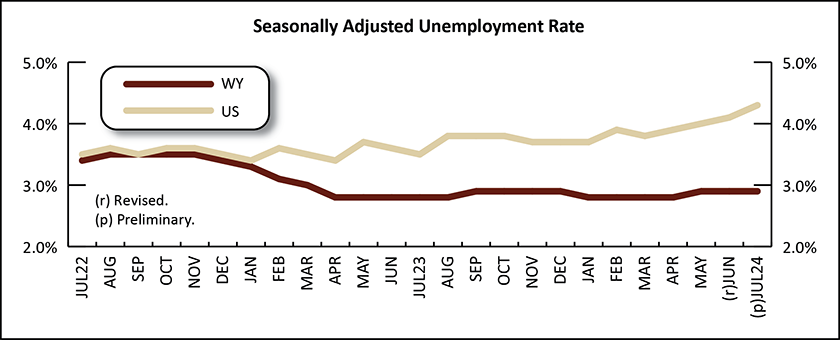Wyoming Labor Force Trends
September 2024 | Volume 61, No. 9
Click Here for PDF
Return to Table of Contents
Wyoming Unemployment Unchanged at 2.9% in July 2024
by: David Bullard, Senior Economist
The Research & Planning section of the Wyoming Department of Workforce Services reported that the state’s seasonally adjusted1 unemployment rate held steady at 2.9% from June to July. Wyoming’s unemployment rate has remained low while the U.S. unemployment rate has increased in each of the past three months, rising from 3.8% in March to 4.3% in July.
From June to July, most county unemployment rates followed their normal seasonal pattern and fell slightly. Seasonal job gains are often seen in July in many different sectors, including leisure & hospitality, construction, and professional & business services. The largest decreases in unemployment occurred in Niobrara (down from 2.1% to 1.8%), Johnson (down from 2.8% to 2.5%), and Albany (down from 3.0% to 2.7%) counties.
Unemployment rates were higher than year-ago levels in every county, indicating that labor markets were not quite as tight as this time last year. Most counties saw unemployment rate increases of two-tenths of a percentage point or less, but larger increases were found in Big Horn (up from 2.7% to 3.3%), Uinta (up from 2.8% to 3.4%), Campbell (up from 2.4% to 2.9%), Laramie (up from 2.6% to 3.1%), and Weston (up from 2.0% to 2.5%) counties.
The highest unemployment rates in July were reported in Uinta County at 3.4%, Big Horn County at 3.3%, Fremont County at 3.3%, and Sweetwater County at 3.3%. The areas with the lowest unemployment rates were Teton County at 1.5%, Niobrara County at 1.8%, and Crook County at 2.1%.
Current Employment Statistics (CES) estimates show that total nonfarm employment in Wyoming (not seasonally adjusted and measured by place of work) rose from 297,500 in July 2023 to 298,700 in July 2024, an increase of 1,200 jobs (0.4%).
R&P's most recent monthly news release is available at https://doe.state.wy.us/LMI/news.htm.



 Hire Wyo
Hire Wyo